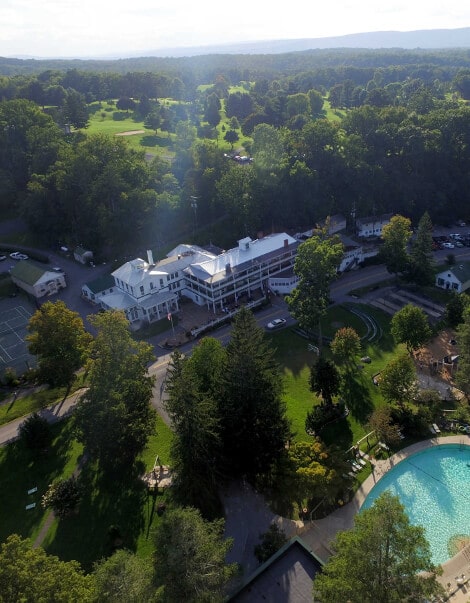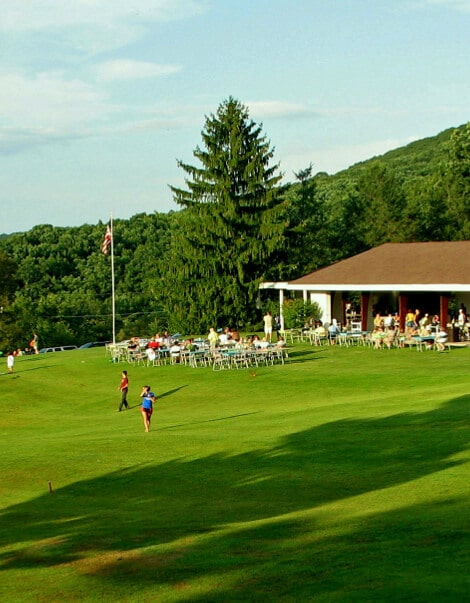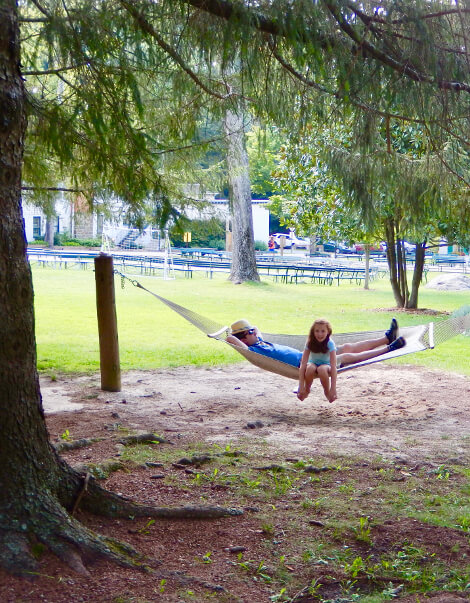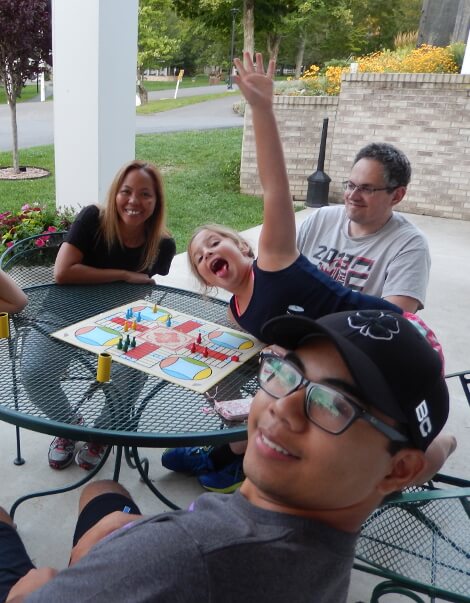Overnight Lodging Closed November 9- April 29 2026 Booking Requests
Capon Golf Course Tips From Our PGA Professional
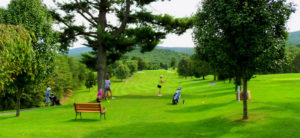 Don’t let the distance (2,913 yards from the blue markers) and the par of 34 fool you. The Golf Course at Capon Springs can and often will play longer and tougher than those stated yardages and par. With that said however, our golf course is very player friendly (no water hazards) and a very playable (wider fairways) by all skill levels. Bring your camera as the mountains of Hampshire County make a wonderful backdrop for the photographer in all us. Following these simple notes should make your round at The Golf Course at Capon Springs & Farms more enjoyable, but then, even a bad round here is not really bad. Once you’re here…you’ll understand. Golf Lesson Rate Sheet
Don’t let the distance (2,913 yards from the blue markers) and the par of 34 fool you. The Golf Course at Capon Springs can and often will play longer and tougher than those stated yardages and par. With that said however, our golf course is very player friendly (no water hazards) and a very playable (wider fairways) by all skill levels. Bring your camera as the mountains of Hampshire County make a wonderful backdrop for the photographer in all us. Following these simple notes should make your round at The Golf Course at Capon Springs & Farms more enjoyable, but then, even a bad round here is not really bad. Once you’re here…you’ll understand. Golf Lesson Rate Sheet
Number 1 (Hill Top) Blue Markers: 347 yards (First and Second Rounds)
Par 4 Gold Markers: 330 yards
Red Markers: 289 yards
This a beautiful starting hole; a slight dogleg left uphill some 50 feet in elevation change to the highest point on the golf course. A drive up the left center of the fairway should (a) stay in the fairway that slopes left to right and (b) give you the best angle into the relatively flat green. Avoid the two bunkers short of the green. Par or birdie on Hill Top will get an excellent round of golf started off right.
Number 2 (Dipsy Doodle) Blue Markers: 168 yards (First Round)
Par 3 White Markers: 126 yards (Second Round)
Gold Markers: 126 yards
Red Markers: 123 yards
A rather simple looking par 3, except for the fact the green slopes away from the front to the back. Long and left are not the play here.Those shots will result in a long second shot back up the hill. A shot left too short could leave a long bunker shot for you to negotiate. Par on Dipsy Doodle is nothing to complain about.
Number 3 (Mountain View) Blue Markers: 376 yards (First and Second Rounds)
Par 4 Gold Markers: 325 yards
Red Markers: 270 yards
A straight away par 4 that is on a hog’s back. Left is trouble with big pines and plenty of the Capon Springs woods to the left of the cart path. Right is the miss here as balls will funnel down to the fifth fairway and the hole will open up if you are far enough right. The green on number 3 is the largest on the course and has subtle undulations throughout the green. Again, par here is a good score.
Number 4 (Postage Stamp) Blue Markers: 114 yards (First Round)
Par 3 White Markers: 120 yards (Second Round)
Gold Markers: 114 yards
Red Markers: 110 yards
Depth perception is the issue on this slightly downhill par 3. The large bunker in front of the green fools you because it is roughly 5 yards short of the green and about 5 feet higher than the surface of the putting green. Bunkers, left and long, catch some errant shots, but beware, shots too far left or long can find the woods. Par is still a good score here.
Number 5 (Mountain Goat) Blue Markers: 367 yards (First and Second Rounds)
Par 4 Gold Markers: 340 yards
Red Markers: 340 yards
Originally a par 5, this hole was shortened to its current length in the 1940’s due to safety concerns with golfers putting on the third green. A drive up the right center will leave a nice uphill approach shot. Add a least one club to your approach shot as it is a 30 foot climb from the 100 yard marker to the center of the green. Shots that come up short will come back toward you in the fairway due to the steep slope at the front of the green. Long of the flagstick is not a bargain either as it leaves a downhill putt on this large green that is about two feet higher on the back half than on the front half. Take par and move on to the sixth.
Number 6 (Lonesome Tree) Blue Markers: 379 yards (First and Second Rounds)
Par 4 Gold Markers: 339 yards
Red Markers: 319 yards
This downhill dogleg right par 4 can and often will fool you. First, avoid the “Lonesome Tree” in the right center of the fairway. Secondly, avoid hitting your tee ball through the fairway, as some small pines just off the left side of the fairway will make your second shot somewhat difficult. Your approach shot will be slightly downhill and shots tend to roll to the back of the green on this hole due to the de-lofted approach shots that carry less spin. This can be a birdie hole if played correctly. If not, bogey or worse can show up on the scorecard.
Number 7 (The Monster) Blue Markers: 511 yards (First Round)
Par 5 White Markers: 509 yards (Second Round)
Gold Markers: 429 yards
Red Markers: 401 yards
Aptly named, the only par 5 on the golf course is a straight away uphill hole that plays much longer than the listed 511 yards. The hole has an elevation change of roughly 70 feet from tee to green. Add to that a steep slope at the front edge of the green which creates a false front for all those balls that don’t make it past the front third of the green.
Your second shot, assuming a good drive, will play about 25 yards longer than the distance on your range finder due to the elevation change. Long hitters don’t worry about flying the green, because it is very hard to do. If you are lucky enough to hit it over the green, a bank behind the green will funnel balls back toward the putting surface. This however might leave a slightly downhill putt on this larger than average green. This hole is a potential birdie hole, and the last real good possibility for birdie on the course.
Number 8 (Easy Bogey) Blue Markers: 238 yards (First and Second Rounds)
Par 3 Gold Markers: 185 yards
Red Markers: 150 yards
Club selection is tricky as this is a downhill par 3 that plays into the prevailing wind most of the time. If you figure the distance correctly with the vertical drop of approximately 20 feet from tee to green, then you must contend with a green that slopes away from you front to back. As the name says…Easy Bogey! Three here can pick up a skin many times.
Number 9 (Three Oaks) Blue Markers: 413 yards (First Round)
Par 4 White Markers: 467 yards (Second Round)
Gold Markers: 347 yards
Red Markers: 302 yards
Another appropriately named hole; three huge oak trees guard the left corner on this dogleg left hole. All three oaks are out of bounds, as out of bounds runs all down the left side of this hole which is adjacent to the Capon Springs Prep Course (par 3 course). This is a risk and reward hole in its purest form. The closer the ball hugs the left side, the shorter the hole and the better the angle into this green that slopes severely from back to front. The safe play is up the right side of the fairway, but that will leave a much longer shot to the putting surface. When you step onto number 1 tee, make sure you note the hole location on the 9th green. Keeping the ball below the hole on the 9th green is essential. Do not be long or up the hill toward the first tee. Missing the green short and left of the front bunker is not always a bad play. If you need birdie to win, be prepared to be the runner-up. Four here is a very good score.
Room Availability & Pricing
Stay in one of our 14 wonderful, unique cottages with a variety of accommodations within each one.
Find Your Room
